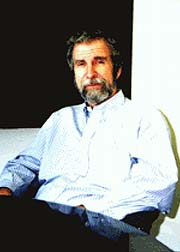UC Riverside geophysicist says triggered deep earthquakes provide insight into how such earthquakes get started

Harry Green, Distinguished Professor of Geology and Geophysics in the Institute of Geophysics and Planetary Physics and the department of earth sciences at UC Riverside
Harry Green comments on a paper in Nature
In a commentary in the Aug. 21 issue of Nature, Harry Green, Distinguished Professor of Geology and Geophysics in the Institute of Geophysics and Planetary Physics and the department of earth sciences at UC Riverside, explains that two large, deep earthquakes (depth > 300 km below the surface of the earth) that occurred in Aug. 2002 in the Tonga subduction zone were causally related.
The Tonga subduction zone is approximately beneath the Fiji Islands in the Pacific Ocean. The two earthquakes were 300 km apart from each other and the difference in their depth was 65 km. Their magnitudes were 7.6 and 7.7.
In the commentary, Green sheds light on a paper by Tibi et al. also appearing in the Aug. 21 issue of Nature. Tibi et al. argue that the second large earthquake was triggered by the passage of seismic waves generated by the first earthquake.
“Tibi and colleagues’ observations are a major advance in understanding deep earthquakes,” Green said. “They might provide a new constraint on the mechanism by which these earthquakes begin. Their work provides a major piece of information as to how earthquakes get started, which may in the long run contribute to the prediction of damaging earthquakes that threaten people in California and elsewhere.”
The authors demonstrated for the first time remote triggering of one deep earthquake by another. “The Tonga earthquakes occurred only 7 minutes apart,” said Green. “Equally interesting, the triggered earthquake occurred in a place where no earthquakes have ever been recorded before.”
Green explained that the observations by Tibi et al. have significant implications for the physical process that initiates deep earthquakes. In the commentary, he outlines the three principal physical mechanisms that have been proposed by geophysicists to explain the initiation of deep earthquakes. “One of these observations can be ruled out by Tibi et al.’s observations,” said Green. “Moreover, we can use the recent seismological work of other researchers to show that one of the remaining two mechanisms is the most probable cause.” That mechanism is ‘phase-transformation-induced faulting,’ which Green and a graduate student discovered in 1989.
The UC Riverside Department of Earth Sciences offers the B.S. degree in geology and geophysics. These B.S.degree programs are designed for students with a strong interest in various aspects of the Earth sciences. The department offers the M.S. and Ph.D. in geological science. The department offers, too, a program built around the core research areas of organic and paleoenvironmental evolution, earthquake science and geodynamics, and quantitative Earth surface processes.
Media Contact
All latest news from the category: Earth Sciences
Earth Sciences (also referred to as Geosciences), which deals with basic issues surrounding our planet, plays a vital role in the area of energy and raw materials supply.
Earth Sciences comprises subjects such as geology, geography, geological informatics, paleontology, mineralogy, petrography, crystallography, geophysics, geodesy, glaciology, cartography, photogrammetry, meteorology and seismology, early-warning systems, earthquake research and polar research.
Newest articles

High-energy-density aqueous battery based on halogen multi-electron transfer
Traditional non-aqueous lithium-ion batteries have a high energy density, but their safety is compromised due to the flammable organic electrolytes they utilize. Aqueous batteries use water as the solvent for…

First-ever combined heart pump and pig kidney transplant
…gives new hope to patient with terminal illness. Surgeons at NYU Langone Health performed the first-ever combined mechanical heart pump and gene-edited pig kidney transplant surgery in a 54-year-old woman…

Biophysics: Testing how well biomarkers work
LMU researchers have developed a method to determine how reliably target proteins can be labeled using super-resolution fluorescence microscopy. Modern microscopy techniques make it possible to examine the inner workings…





















